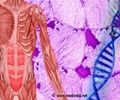A study published online March 19 in the Journal of the National Cancer Institute says that certain rare mutations in the ataxia telangiectasia mutated gene, combined with radiation exposure, may increase a woman's risk of developing a second cancer in the opposite breast.
Breast cancer survivors are at increased risk of developing a second cancer in the other, or contralateral breast, compared to women who have not had breast cancer. The ATM gene is known to play a role in cells' response to DNA damage caused by ionizing radiation, another breast cancer risk factor. But it has been unclear whether women who carry ATM mutations are especially susceptible to radiation-induced breast cancer.To address this issue, Jonine Bernstein, M.D., of the Memorial Sloan-Kettering Cancer Center in New York, and colleagues, compared ATM mutations among women who had developed a second cancer in the contralateral breast to mutations in those who had a cancer in only one breast. The women were participants in the Women's Environment, Cancer, and Radiation Epidemiology (WECARE) Study, an international case–control study. There were 708 case subjects—women with contralateral cancer—and 1,397 control subjects who did not have a second cancer but were similar to the case subjects in other respects, such as age and race.
All the women underwent full mutation screening of the entire ATM gene. For those who had received radiation therapy, the researchers estimated the amount of radiation to the contralateral breast using treatment records and radiation measurements.
Women who carried certain rare ATM mutations--missense variants predicted to be deleterious--and who also received radiation had a higher risk of contralateral breast cancer compared with women who did not have these mutations and had not had radiation. The difference was statistically significant. Women with both a mutation and radiation exposure also had a higher risk than women who had a mutation but no radiation exposure.
The authors note that the missense variants were found in fewer than 1% of study participants. They conclude that breast cancer survivors who do have such variants and who also received radiation may be at an elevated risk for a contralateral breast cancer. "However, the rarity of these deleterious missense variants in human populations implies that ATM mutations could account for only a small portion of second primary breast cancers," they write.
In an accompanying editorial, David Brenner, Ph.D., of Columbia University Medical Center in New York, notes that strategies to prevent second cancers, such as use of tamoxifen in women with estrogen receptor positive tumors, are desirable. One potential option, he suggests, is prophylactic irradiation of the contralateral breast, using doses too low to cause tumors but sufficient to kill premalignant cells.
Advertisement
Advertisement
RAS













